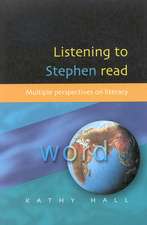Language Planning in Africa: The Cameroon, Sudan and Zimbabwe
Editat de Nkonko Kamwangamalu, Richard Baldauf Jr., Robert Kaplanen Limba Engleză Paperback – 14 oct 2024
The extended case studies contained in this volume draw together the literature on each of the polities to present an overview of the existing research available, while also providing new research-based information. The purpose of this volume is to provide an up-to-date overview of the language situation in each polity based on a series of key questions, in the hope that this might facilitate the development of a richer theory to guide language policy and planning in other polities where similar issues may arise.
This book comprises case studies originally published in the journal Current Issues in Language Planning.
| Toate formatele și edițiile | Preț | Express |
|---|---|---|
| Paperback (1) | 253.81 lei 6-8 săpt. | |
| Taylor & Francis – 14 oct 2024 | 253.81 lei 6-8 săpt. | |
| Hardback (1) | 499.39 lei 6-8 săpt. | |
| Taylor & Francis – 14 iun 2013 | 499.39 lei 6-8 săpt. |
Preț: 253.81 lei
Preț vechi: 303.94 lei
-16% Nou
Puncte Express: 381
Preț estimativ în valută:
48.57€ • 50.84$ • 40.42£
48.57€ • 50.84$ • 40.42£
Carte tipărită la comandă
Livrare economică 31 martie-14 aprilie
Preluare comenzi: 021 569.72.76
Specificații
ISBN-13: 9781032925295
ISBN-10: 1032925299
Pagini: 246
Dimensiuni: 174 x 246 mm
Greutate: 0.46 kg
Ediția:1
Editura: Taylor & Francis
Colecția Routledge
Locul publicării:Oxford, United Kingdom
ISBN-10: 1032925299
Pagini: 246
Dimensiuni: 174 x 246 mm
Greutate: 0.46 kg
Ediția:1
Editura: Taylor & Francis
Colecția Routledge
Locul publicării:Oxford, United Kingdom
Public țintă
Academic, Postgraduate, and ProfessionalCuprins
1. Language policy and planning in Africa: Cameroon, Sudan and Zimbabwe Nkonko M. Kamwangamalu, Richard B. Baldauf Jr. and Robert B. Kaplan 2. The Language Situation in Cameroon Jean-Paul Kouega 3. The sociolinguistics of nationalism in the Sudan: the politicisation of Arabic and the Arabicisation of politics Ashraf Abdelhay, Busi Makoni, Sinfree B. Makoni and Abdel Rahim Mugaddam 4. A Very 'Oily' Sociolinguistics of the 'New' Sudan: Old Wine in New Bottles Busi Makoni, Ashraf Abdelhay and Sinfree B. Makoni 5. Zimbabwe Colonial and Post-Colonial Language Policy and Planning Practices Sinfree B. Makoni, Busi Dube and Pedzisai Mashiri 6. A critical analysis of the historical and contemporary status of minority languages in Zimbabwe Sinfree B. Makoni
Notă biografică
Nkonko M. Kamwangamalu is Professor of Linguistics at Howard University, USA. He has published numerous articles in refereed journals, is author of The Language Planning Situation in South Africa (2001), and co-editor of Language and Institution in Africa (2000). His research interests include language policy and planning, codeswitching, World Englishes, language and identity, and African linguistics.
Richard B. Baldauf, Jr. is Professor of TESOL in the School of Education at the University of Queensland, Australia. He has published numerous articles in refereed journals and books, and is co-author of Language Planning from Practice to Theory (1997), Language and Language-in-Education Planning in the Pacific Basin (2003), and Planning Chinese Characters: Evolution, Revolution or Reaction (2008).
Robert B. Kaplan is Emeritus Professor of Applied Linguistics at the University of Southern California, USA. He has published numerous books and refereed articles, is the founding Editor-in-Chief of the Annual Review of Applied Linguistics, and has been a member of the editorial board of the Oxford International Encyclopedia of Linguistics (2002) and Editor of the Oxford Handbook of Applied Linguistics.
Richard B. Baldauf, Jr. is Professor of TESOL in the School of Education at the University of Queensland, Australia. He has published numerous articles in refereed journals and books, and is co-author of Language Planning from Practice to Theory (1997), Language and Language-in-Education Planning in the Pacific Basin (2003), and Planning Chinese Characters: Evolution, Revolution or Reaction (2008).
Robert B. Kaplan is Emeritus Professor of Applied Linguistics at the University of Southern California, USA. He has published numerous books and refereed articles, is the founding Editor-in-Chief of the Annual Review of Applied Linguistics, and has been a member of the editorial board of the Oxford International Encyclopedia of Linguistics (2002) and Editor of the Oxford Handbook of Applied Linguistics.
Descriere
This volume focuses on language planning in the Cameroon, Sudan and Zimbabwe, explaining the linguistic diversity, the historical and political contexts and the current language situation (including language-in-education planning), the role of the media, the role of religion and the roles of non-indigenous languages. This book com














